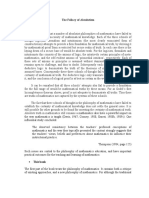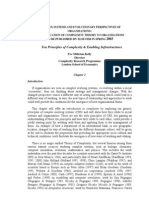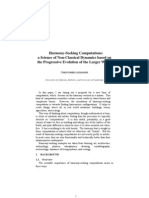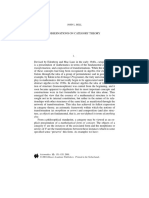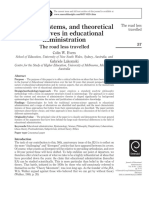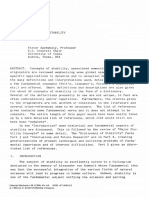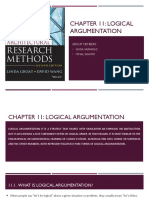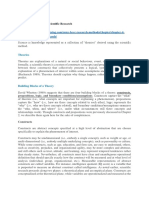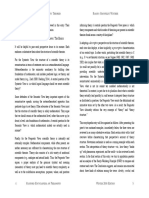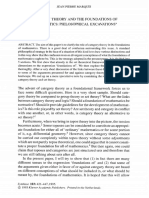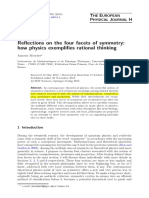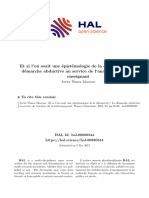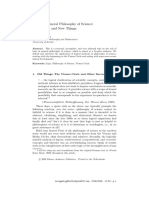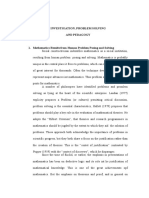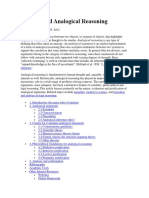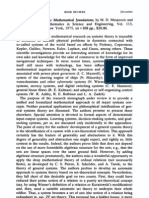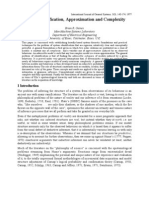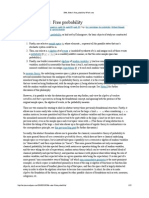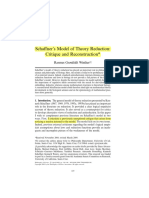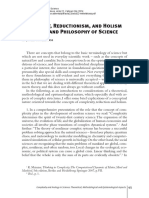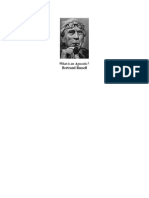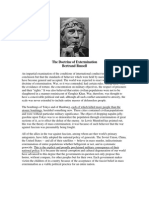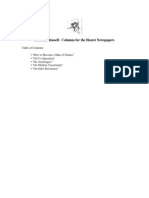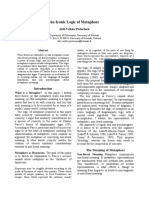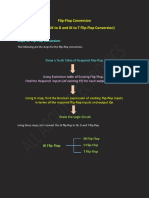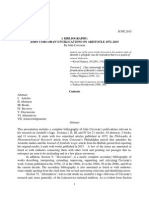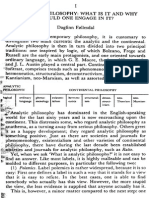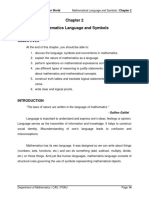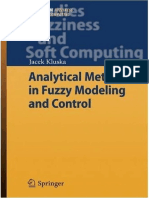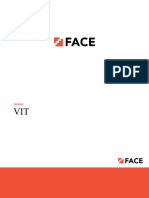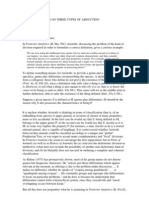The Role of Axiomatisation in Mathematics and Mathematics Teaching
The Role of Axiomatisation in Mathematics and Mathematics Teaching
Uploaded by
UdayCopyright:
Available Formats
The Role of Axiomatisation in Mathematics and Mathematics Teaching
The Role of Axiomatisation in Mathematics and Mathematics Teaching
Uploaded by
UdayOriginal Title
Copyright
Available Formats
Share this document
Did you find this document useful?
Is this content inappropriate?
Copyright:
Available Formats
The Role of Axiomatisation in Mathematics and Mathematics Teaching
The Role of Axiomatisation in Mathematics and Mathematics Teaching
Uploaded by
UdayCopyright:
Available Formats
Role of Axiomatization, Michael de Villiers, 1986
The Role of Axiomatisation in Mathematics and Mathematics Teaching
Michael de Villiers
Originally published in 1986 Research Unit for Mathematics Education (RUMEUS) University of Stellenbosch South Africa
Role of Axiomatization, Michael de Villiers, 1986
Table of Contents
PREFACE 1. 2. 3. 4. 5. 6. 7. 8. 9. INTRODUCTION CONSTRUCTIVE AXIOMATIZATION DESCRIPTIVE AXIOMATIZATION SYSTEMATIZATION THE FUNCTIONS OF AXIOMATIZATION IN MATHEMATICS AN AXIOMATIC-DEDUCTIVE APPROACH TO TEACHING CRITICISM OF AXIOMATIC DEDUCTIVE APPROACHES TO TEACHING DESCRIPTIVE APPROACH TO TEACHING THE ROLE OF AXIOMATIZATION IN MATHEMATICS TEACHING AND LEARNING 10. VARIABILITY OF APPROACHES 11. NOTES 12. BIBLIOGRAPHY 20 22 24 26 3 4 4 6 8 8 12 14 17
Role of Axiomatization, Michael de Villiers, 1986
Preface
South Africa is one of the last vestiges of formal "Euclidean" Geometry as a compulsory part of the mathematics curriculum in the senior secondary school. The rationale for including formal geometry in the school curriculum is twofold: it is seen as a vehicle for teaching and learning deductive thinking ("proof"), and also as a first encounter with a formal axiomatic system. Contemporary thinking in Mathematical Education provides different interpretations of this rationale than those of the past. The traditional view of deductive argument as being purely a method for establishing validity, is being replaced by a more authentic perspective assigning different roles to deductive argument, and specifically the role of producing formal axiomaticdeductive descriptions of domains of concepts and propositions of which the validity are already settled.
In the traditional mathematics curriculum, pupils had been confronted with a formal system of geometric concepts and propositions as a finished product. Modern views (e.g. that of
Freudenthal) hold that pupils should rather be involved in the process of creating such a system. An alternative approach to formal geometry in South African schools had been the object of extensive research at the University of Stellenbosch since 1976 (cf. Human et al, 1986).
In the present report Michael de Villiers conducts a searching analysis of the nature and purposes of axiomatisation and related processes, providing an epistemological background for teaching with a view to foster understanding of the nature and purposes of formal systems.
P.G. Human, Director: RUMEUS March 1986
Role of Axiomatization, Michael de Villiers, 1986
Abstract
Various functions of axiomatization as a typical mathematical process are analysed and discussed. A distinction is made between descriptive and constructive axiomatization. This distinction is also applied to mathematics teaching and a case is made out for a more extensive use of descriptive axiomatization in our teaching.
Introduction
It is probably somewhat unfashionable in the heyday of the "back to basics" movement to write about the teaching of axiomatization and emphasizing the structural aspects of mathematics in mathematics teaching (see Allen, Thom). However, the importance of
axiomatization in modern mathematics and its implications for teaching, simply cannot be ignored. Several authors have in recent years analysed the nature of axiomatization, and its relation to mathematics teaching. This report attempts to synthesize some of these analyses by looking at the various roles and functions of axiomatization in mathematics and mathematics teaching.
Constructive Axiomatization
Constructive ("a priori") axiomatization takes place when a given set of axioms is changed through the exclusion, generalization, replacement or addition of axioms (or subsets of axioms) to that set, from which totally new content is then constructed in a logical deductive way (See Human (1978, 164-165); compare Krygowska (1971, 129). This process is illustrated in Figure 1. The development of the non-Euclidean geometries essentially took place in this manner. For instance, the variation of the Playfair axiom in the axiom set of Euclidean Geometry by Bolyai (1802-1860) and Lobachevsky (1793-1856), led via logical deduction, to the discovery of the hyperbolic geometry. In this case, new results and theorems were derived from previously
Role of Axiomatization, Michael de Villiers, 1986
formulated axioms; therefore, "a priori". Also note that the choice of axioms during constructive axiomatization is usually not completely arbitrary, as sometimes propounded by an extreme formalist view of mathematics. (See Davis & Hersh, 340). In this regard, Morris Kline (48) quotes the mathematician Rolf Nevanlinna: "The setting up of entirely arbitrary axiom systems as a starting point for logical research has never led to significant results ...."
Existing Axioms
Variation of Axioms Further Deduction
New Theorems Figure 1 It should also be remembered that the substitution of the Playfair axiom by its negation by Saccheri (1667-1733) was done in an attempt to prove the Playfair axiom by "reductio ad absurdum". In other words, the original idea was to consequently construct a more economical axiom set for Euclidean Geometry by excluding the Playfair axiom after it had been proved. As Peter Hilton (91) has pointed out, the development of a mathematical structure is seldom done blindly and in isolation of specific problems:
Role of Axiomatization, Michael de Villiers, 1986
"The mere building of mathematical structure, with no thought to the problems to which that mathematical structure can be applied, is not, by any conceivable standards, a worthy mathematical activity, but that is a caricature of the axiomatic method."
Descriptive Axiomatization
With descriptive ("a posteriori") axiomatization is meant the selection of an axiom set from an already existing set of statements. (See Human (1978, 165) ; compare Krygowska (129-130). Scandura (55) defines this type of axiomatization1 as follows: "For many sets of mathematical ideas (properties), there is often a subset from which all the other ideas (properties) may be deduced. (Indeed there may be many such subsets for each set). Such a subset is said to form an axiom system, and the ideas or properties belonging to this subset are called axioms. Axiomatization is the process of selecting just such a subset from a given set of mathematical properties."
Logically Unrelated Statements
Logical Relationships Analysed
Systematization
ANALYSIS
SYNTHESIS
Axioms
Figure 2 This "a posteriori" process is summarised in Figure 2. (From De Villiers, 1985, Vol. 2, 50; compare with Human, 1978, 18). In danger of possible oversimplification, this complex
Role of Axiomatization, Michael de Villiers, 1986
process can briefly be described as follows. Firstly, the logical relationships (implications) between the various logically unrelated or only partially related statements are analysed (or perhaps even re-examined after a previous analysis). Lakatos (5) has pointed out that this process of analysis and construction of proofs, may actually extend over a considerable period of time "through the incessant improvement of guesses by speculation and criticism, by the logic of proofs and refutations."
Finally, a set of axioms is then selected as the starting point of the deductive development, and the remaining statements are re-structured and recast into a deductive frame. This selection of axioms may, on the one hand, be done with the criterium of the intuitive acceptability or "selfevidency" of the statements ("classical" axiomatization), or with the criterium of the relative ease by which other statements may be derived from the axioms ("modern" axiomatization). (See Human, 1978, 166). At the same time the utmost care is usually taken to avoid any circular arguments and to comply with the conditions of independency, completeness and consistency which apply to axiomatic structures. More often than not, the possibility of logically alternative systematizations of the same content also presents itself naturally during such a re-examination. A choice may now be made between such alternatives from the "modern" point of view, and using criteria such as simplicity and length of proofs involved, hierarchical structure, elegance, etc.
Since "a posteriori" axiomatization exposes the underlying and often obscured mathematical structure of a previously familiar area, or perhaps more precisely, identifies a set of axioms from which all its other properties may be derived, it can also be viewed as a process of abstraction whereby the analysis of the logical relationships between statements or concepts becomes the dominant mode of thinking, and no longer the intuitive interpretations which initially may have been attached to them. Freudenthal (1973, 451) refers to this dramatic change in style of thinking, as the "cutting of the ontological bonds." Wittmann (1981) and
Role of Axiomatization, Michael de Villiers, 1986
Skemp (1971, 54-67) also describe a similar transitional phase from intuitive to reflective thinking, and view the latter as a more critical extension of the former. In the three level Van Hiele model, "a posteriori" axiomatization corresponds to a transition from the two lower levels to the third Van Hiele level of logical implications. (See Note 2 for further details).
Systematization
Although axiomatization and systematization are most certainly distinguishable from one another, they are, however, fairly inseparable. If systematization is broadly viewed as the construction of an axiomatic deductive system, it clearly involves the selection or variation of axioms (descriptive or constructive axiomatization), as well as the logical deductive ordering of axioms, definitions and theorems. However, in the case of descriptive axiomatization, the
logical analysis of the relationships between statements, usually not only suggests which statements may be chosen as axioms, but also how the statements should be logically ordered.
Let us, for instance, assume that we have a small number of mathematical statements, say A, B, C and D. Let us now say that on analysing the logical relationships between these statements, we find that statement D can be proved by using C, C by using A, which in turn is based upon B (thus BA CD). Then it is not only clear that B must be accepted as an axiom, but also that the statements should be written up in the order B, A, C and D to form an axiomatic deductive system.
The Functions of Axiomatization in Mathematics
Whereas the function of constructive axiomatization is largely one of the creation of new knowledge, the function of descriptive axiomatization is largely that of the reorganization of existing mathematics. It should also be noted that in the latter case the role of mathematical proof is not really so much that of the verification (checking the validity) of results, as that of the systematization of results, including those that are intuitively acceptable into a logical
Role of Axiomatization, Michael de Villiers, 1986
ordering (cf. Bell, 24). The axiomatic deductive systematization of previously formulated concepts and propositions, however, can be seen as a means of "verification" in the sense that we can use it to check for inconsistencies or circular arguments. With regard to constructive axiomatization, proof assumes the role of logical deduction, which may lead to the discovery of new propositions.
Although some mathematicians like Morris Kline (48-49) have referred rather derogatorily to axiomatization by calling constructive axiomatization "postulate piddling", and claiming that a topic was ready for "burial" when the time arrived to "a posteriori" axiomatize and systematize it, we cannot ignore the importance of either. Both methods have contributed to major developments within contemporary mathematics this century and is therefore essentially part of modern mathematical thought. Despite the fact that descriptive axiomatization does not necessarily create new mathematical knowledge like constructive axiomatization, it nevertheless has many important functions in mathematics, including: It helps with the identification of hidden or not explicitly stated assumptions. (For instance, Pasch's discovery in 1882 that the proofs of several important theorems in Euclidean Geometry depended on an assumption which was not included in the axioms). It unifies and simplifies mathematical theories by integrating unrelated statements, theorems or concepts with one another which leads to an economical presentation of mathematical results. (For instance, the clarification and incorporation of the prodigious discoveries of famous mathematicians like Gauss or Riemann into the main stream of mathematics.) It aids the identification of possible circular arguments or inconsistent which could have occurred during the deductive systematization/explanation ("proof") of previous results. (The axiomatic re-organization of "analysis" during the 18th and 19th centuries, was partly motivated by the uncertainty about the validity of some of its results. (See Kramer, 528549)).
Role of Axiomatization, Michael de Villiers, 1986
It provides a certain global perspective or broad overview of a topic by exposing the underlying axiomatic structure of that topic (e.g. the field structure of the real numbers).
It is helpful for applications both within and outside mathematics, since one needs only to check if all the axioms of a certain structure is valid under the area of investigation, to know if the structure as a whole is applicable or not. (An example within mathematics is the application of the group concept to the symmetric transformations (symmetries). An
example outside mathematics, is the realisation that if switches and switching circuits agree with the five Boolean axioms, one could immediately accept without further proof that the Boolean theorems, which can be derived from the axioms, will also hold for switching circuits. Axiom systems may also deliberately be constructed as models for practical situations outside mathematics, for example, for voting bodies (cf. Steiner, 181-201)). The reorganization of areas may lead to the discovery of alternative, independent systems which are more economical, elegant and powerful than existing ones. As a case in point, the Bachman axioms substantially simplify the field of projective geometry, compared to more traditional axiomatizations, by including Pappus' theorem in an alternative axiom set, while still complying to the conditions of independency and completeness. Similarly, a choice may be made between several logically equivalent definitions for the same concept by checking to see which one leads to simpler and less complicated proofs of its other properties (See Human et al, 1984, 44)).
When we look at the historical development of many topics, it is important to note that axiomatization and systematization has mostly been a re-organization of earlier discovered results. As Hull (29) has so eloquently described it: "When we look at the history of mathematics, we see a kind of lifelike elemental rhythm. There are periods of exuberant untidy growth, when exciting, vital structures rise upon untried assumptions, and loose ends lie about all over the place. Logic and precision are not unduly honoured; because restlessness, ethusiasm, daring, and ability to tolerate a measure of
Role of Axiomatization, Michael de Villiers, 1986
confusion, are the appropriate qualities of mind at these times. Such periods are followed by pauses for consolidation, when the analysts and systematisers get to work; material is logically ordered, gaps are filled, loose ends are neatly tied up, and rigorous proofs supplied. Solemn commentators sit in judgement upon great innovators. Whole areas of mathematics are formed into deductive systems, based on sets of unproved, explicitly stated axioms. Work of this kind, at its best, is also creative: new ideas grow from the critical examination of old, and the cycle is renewed. Periods of these two kinds may overlap; or a growth period in one field may coincide with a period of consolidation in another: but the fundamental alternation would seem to subsist generally."
From the above it is clear that the continual re-organization and restructuring of mathematics is a fundamental characteristic of all branches of mathematical activity. As Hull points out in most cases the theorems and powerful techniques were already in existence and being applied to many problems, long before their eventual re-organization into an axiomatic deductive system. Authors like Polya, Kline, Hilton and others have also repeatedly stressed that the discovery of new results during such periods were mostly made through the inductive processes of generalizing, abstracting, analogizing, guessing, hypothesizing, etc. and not by formally using logical deduction.
Although many topics were initially abstracted from practical situations through experimental evidence or intuition, there eventually came a time when the propositions and concepts were logically linked together in a deductive manner. Famous examples in this regard were the development and use of geometry prior to its systematization by Euclid, and the intuitive development of analysis by Newton and Leibniz, long before its re-organization by Cauchy and Weierstrass around the concepts of limit and continuity. From the historical point of view, axiomatization is clearly seldom "a priori", but mostly the "a posteriori'' re-organization of
Role of Axiomatization, Michael de Villiers, 1986
existing knowledge and the continual incorporation of new results into existing deductive frameworks (and vice versa), with a systematized deductive system the inevitable end product. New knowledge in mathematics is, in any case, very seldom created in a purely constructive axiomatic way: that is inventing new theorems by starting out from previously chosen axioms, and using merely logical deduction. When one looks at the history of mathematics, one finds that this is rather the exception than the rule. Ren Thom (697) essentially stresses the same viewpoint in the following way: "During the past few years the importance of axiomatization as an instrument of systematization and discovery has been much emphasized. As a method of systematizing, it is certainly effective; as for discovery, the matter is more doubtful. It is characteristic that no new theorem of any importance came out of the immense effort at systematization of Nicolas Bourbaki ... "
An Axiomatic Deductive Approach to Teaching
An axiomatic deductive approach is used when an unfamiliar topic (a set of unfamiliar statements and concepts) is presented to students by means of the initial introduction of the axioms and definitions of that topic, and logically deriving the other statements (theorems) and properties from them. (See Human, 1978, 182). Lakatos (142) has also referred to this
approach as the "deductivist style". This is not only a very popular approach in advanced mathematical textbooks, but has also to some degree infiltrated the style and structuring of (traditional) school textbooks.
This "deductive" or "formalist" style of thinking is analogous to the way in which a mathematical theory and its applications are generally taught, when the former is presented "a priori", while applications (if any) come much later. Quite typically, algorithms, rules or other manipulative procedures are also first introduced by the teacher, and only then followed by the context in which they are to be applied. An example would be to first teach pupils how to fully
Role of Axiomatization, Michael de Villiers, 1986
factorise various quadratic expressions, before using it to solve quadratic equations (and real world or word problems which give rise to quadratic equations).
Some of the many reasons why teachers (and textbook authors) may choose to use this approach are: it is the accepted manner in which mathematicians report their research results; it is a very economical presentation, especially if a large volume of work is to be covered in a short time (See Davis and Hersh, 282); it explicitly shows the logical deductive relationships between the axioms, definitions and theorems (see Dieudonn, 16-17); since the topic is being presented in an axiomatized form, the possibility of circular arguments and inconsistencies arising, is "a priori" eliminated (likewise, any uncomfortable questions from one's students are anticipated and avoided). (See Bourbaki, 223, Dieudonn, 17); the expectation of many students that the teacher should rather teach the material in a clear well-organized manner so that it is easily learnt and remembered, than emphasize "untidy" mathematical processes like problem-solving, generalization, hypothesizing, axiomatization, etc. (See Hativa, 611). the mathematical inability, ignorance, unpreparedness or lack of self-confidence of teachers to deviate from the narrow constraints of an axiomatic deductive approach (See Dieudonn, 16, Davis & Hersh, 282-283); it fits the formalistic view or philosophy of mathematics, which sees mathematics virtually only as formal derivations from carefully defined axioms (See Lakatos 142-143, Hersh, 3234); through lack of experience in being creative in mathematics, some teachers seem to confuse real creativity in mathematics with the end-result thereof. (Having usually only been exposed to axiomatic deductive approaches themselves, they naturally develop a formalistic
Role of Axiomatization, Michael de Villiers, 1986
view which they carry with them back into the schools, and so perpetuating the cycle (See De Villiers, 1984, 102-105).
Criticism of Axiomatic Deductive Approaches to Teaching
Criticism from many mathematicians and mathematics educators like Freudenthal, Hersh, Human, Kline, Fischbein, Lakaton, Van Hiele and others, has been levelled at this kind of mathematics teaching, both from a philosophical as well as a pedagogical point of view. Some of the many points of criticism, some of which overlap, are: We are intellectually dishonest towards our students by confronting them with ready-made axiomatic systems from which they are only supposed to draw some logical deductions, thereby giving them the false impression that that is what mathematics is all about. As Hersh (33) puts it, we cannot "leave unquestioned the dogma that real mathematics is precisely formal derivations from formally stated axioms." Such axiomatic deductive presentations only (partially) demonstrate axiomatization as a constructive activity, and seldom as a descriptive and re-organizational activity. This gives a distorted view of, not only axiomatization as a mathematical activity, but also of the way in which most new mathematics is created. (See Hull, 30, Lakatos, 142-152). This may easily lead to common misconceptions about the nature of mathematics (including axioms and axiomatic structures) among high school pupils, as well as university students. In a study by De Villiers (1984), for instance, about 70% of the prospective secondary school mathematics teachers in their final year at 11 South African universities, answered affirmatively to the following statement: "New mathematics is mostly created by making step by step deductions from already existing knowledge." In the same study, over 50% of the same students also responded positively to the statement: "The discovery of new mathematical content by researchers is always preceded. by the "a priori" (prior) formulation of definitions."
Role of Axiomatization, Michael de Villiers, 1986
The arbitrary nature of axiomatic systems is not illustrated if only one set of axioms, or definitions of concepts, and only one specific axiomatic-deductive ordering is presented to students, which unfortunately is what frequently happens with an axiomatic deductive approach;
No motivation for the study of a certain topic is usually provided, other than by perhaps appealing to one's sense of logic and precision: the theoretical or practical questions which may have provided the motivation for the development of the content are therefore completely ignored. (See Kline, 211). Besides the pedagogical importance of questions, Hull (30) also emphasizes the central part played by questions in the development of new mathematics when he concludes: "Let us remember that mathematics begins with questions, and only ends in axioms." This approach is educationally unsound, since students are denied any participation in the selection of axioms or the restructuring of the content, with the consequence that they do not know where the axioms came from, nor why they are essential, nor can they understand why certain statements are called axioms, while other equally obvious or selfevident statements are called theorems; (See Kline, 116, Preudenthal, 450456) Since the reason for the necessity of proofs is usually only given as only that of the verification ("making sure") of results, with the exclusion of other reasons like the systematization or illumination (clarification) of results, students do not understand or experience the proofs of self-evident statements as meaningful ("why prove the obvious?"). (See Bell, 24). {In the aforementioned study by De Villiers (1984), 55% of the students for instance, responded positively to the statement: "The only function of proof is to obtain assurance of the validity (or invalidity) of statements" In an open-ended question: "Why do we prove that the sum of the interior angles of a triangle are 180 degrees, even though we can confirm it experimentally?" only 19% of the students responded with answers that indicated that they understood that the proof of this statement had more to do with its systematization, explanation and incorporation into a
Role of Axiomatization, Michael de Villiers, 1986
deductive system, than its actual verification (as a sort of truth). The latter was given as a reason by 66% of the students}. It can be psychologically damaging, in so far as some students may develop feelings of inferiority, as Morris Kline (177) explains: "The deductive presentation of mathematics is psychologically damaging because it leads students to believe that mathematics is created by geniuses who start with axioms and reason directly and flawlessly to theorems. Given this impression of elevated, far-ranging minds, the student feels humbled and even depressed about his own capacities, especially when the obliging professor presents the material as though he too is genius in action."; Axiomatic deductive approaches tend to dogmatism and promote authoritarianism (See Davis and Hersh, 282283). Lakatos (142) also describes this danger: "Mathematics is
presented as an ever-increasing set of eternal, immutable truths. Counter examples, refutations, criticism cannot possibly enter. An authoritarian air is secured for the subject by beginning with disguised monster-barring and proof-generated definitions and with the fullyfledged theorem, and by suppressing the primitive conjecture, the refutations, and the criticism of the proof." More importantly, axiomatic structures and deductive proof belong to the third level of the three level Van Hiele model, and since most pupils are entering high school usually only at the first or second Van Hiele level (See Usiskin, Njisane), they cannot but interpret work presented in this manner as totally meaningless and incomprehensible since no provision is usually made in such approaches to help pupils progress towards the necessary or required levels.2 (The same problem might apply to university level mathematics, since Mayberry (1983) found. that a large percentage of prospective elementary school teachers were at very low Van Hiele levels); Such direct approaches to the teaching of axiomatic structures as finished products, therefore invariably again to load to the rote learning and memorization of axioms, definitions, theorems and lemmas and their corresponding proofs; with little or no
Role of Axiomatization, Michael de Villiers, 1986
understanding of their meanings at all. (See Ausubel, 107). {A study by Human et al (1984) showed that very few pupils in a traditional (axiomatic deductive) approach could meaningfully distinguish between axioms and theorems, or realized that certain statements had to be accepted as axioms to prove other statements an theorems. Similarly, De Villiers (1984) found that about half of the prospective mathematics teachers in the study still held a "classical" view of the nature of axioms, namely, that they were accepted without proof due to their self-evidency.} The students themselves do not become skilful in the application of creative mathematical processes, like abstraction, generalization, constructive axiomatization (defining), drawing of analogies, etc., nor those of a more organizational nature like descriptive axiomatization (defining), systematization, construction of proofs, etc., since only the end products of these processes are given directly to them. {De Villiers, (1984), for instance, found that on average about 30% of the students in the study could not judge the validity of mathematical definitions like "A square is a quadrilateral with four equal sides." (These findings can most probably be explained by the fact that students have had little or no experience in defining such figures, and have not developed an understanding of the criteria of completeness and economy (necessity and sufficiency) to which definitions should comply.) Finally, direct axiomatic-deductive approaches of this kind are, not only to a certain degree an insult to our students, but also a gross underestimation of their abilities (given the time, motivation, opportunity, encouragement and required Van Hiele level) to axiomatize and systematize mathematical topics by themselves. {As has been indicated in a study by Human et al (1984). See also Human (In press), Freudenthal, 1973, 454-455)}.
Descriptive Approach to Teaching
What other alternative approaches are there? Freudenthal (1973, 541) would immediately respond3: "Should axiomatics be taught in schools? If it is taught in the form it has been in the
Role of Axiomatization, Michael de Villiers, 1986
majority of projects in the last few years, I say "no". Prefabricated axiomatics is no more a teaching matter in school instruction than is prefabricated mathematics in general. But what is judged to be essential in axiomatics by the adult mathematician, I mean axiomatizing, may be a teaching matter. After local organization the pupil should also learn organizing globally and finally cutting the ontological bonds." Freudenthal therefore clearly suggests that we should essentially teach axiomatic structures via the process of a posteriori axiomatization, as it most frequently occurs in mathematics, namely as a process of re-organization as represented in Figure 2. It should therefore predominantly be taught in a descriptive, a.posteriori manner (at least, as a first introduction) rather than in the traditional deductivist style as an "a priori" activity. 4 Such an approach implies that axiomatization and systematization should only occur after the content has already been introduced and developed by the teacher and/or the pupils, and should not be used as the means by which new content is introduced to pupils. We should therefore distinguish between two distinct teaching and learning phases, namely: 1. the informal, intuitive acquisition and verification of results; and 2. the deductive re-organization of familiar and previously accepted results in (1).
Hull (30) describes how such an alternative approach could be implemented: "The early stages should be exploratory. Experiment, intuition and informal inference should all be involved; the approach should be through particular problems and situations which excite curiosity; general principles should be only gradually evolved; while formal rigour will be out of place. There should then be a stage of systematization, when regions of knowledge begin to show an increasing logical articulation, and proofs (when they are really necessary) are subject to a gradually more rigorous examination. Areas of organization will grow, and merge into one another; precise definitions and sets of axioms may eventually appear."
Kline (149) agrees with the viewpoint that the early stages should be intuitive as follows:
Role of Axiomatization, Michael de Villiers, 1986
"The proper pedagogical approach to any new subject should always be intuitive. The strictly logical foundation is an artificial reconstruction of what the mind grasps through pictures, physical evidence, induction from special cases, and sheer trial and error."
In contrast to most "deductivist" approaches, the intuitive development of the content may from the beginning also be intimately interwoven with its applications, whether of a practical or theoretical origin. (For an example of an approach where the final stage of descriptive axiomatization was initially preceded by the development of a mathematical model from a practical context, consult De Villiers (In press (b)).
Freudenthal (1973, 151, 451-461) also points out that the axiomatization process can be carried out in stages, first "locally" and gradually more "globally". For instance, by first axiomatizing the properties of specific geometric concepts (e.g. defining a parallelogram), before axiomatizing the geometric structure as a whole in terms of its axioms.
Also important in such an "axiomatization in action" approach should be some participation of pupils in the actual re-organization of the content, without which one can perhaps axiomatically say,. that pupils will hardly be able to construct a really meaningful interpretation and understanding of axiomatic structures. This idea is strongly supported by the constructivists view of knowledge (see Confrey, 1985a & b) which emphasizes the essential role of one's own active constructions in developing an individual and personally meaningful understanding of mathematical reality.
Pupils will, therefore, only come to a really deep understanding of axiomatization, and of the nature of axiomatic structures, by being themselves involved in the activities of analysing the logical relationships between the statements and concepts within a specific mathematical area, selecting the axioms according to chosen criteria, and finally re-organizing and re-structuring the
Role of Axiomatization, Michael de Villiers, 1986
content-matter accordingly. Not only would it be better teaching of mathematics, but also, and perhaps most of all the teaching of better mathematics. Most assuredly, the essence of mathematics does not lie so much in the knowledge of certain mathematical facts, as in the act of doing mathematics; that is mathematization. (See Freudenthal, 1973, 132-146). Such an
approach, of course, is only viable on condition that pupils have already obtained the required Van Hiele levels and are sufficiently motivated.
The Role of Axiomatization in Mathematics Teaching & Learning
The partial freedom of choice with regard to which results could be taken as axioms, or how the various theorems could be ordered can also be of significant pedagogical value. So, for instance, it may be pedagogically expedient to consider the congruence theorems in Euclidean plane geometry as axioms, since so many important (and more interesting) theorems depend on them, and it takes much too long in a traditional deductive devevelopment to prove them as theorems themselves. One may, therefore, apply "a posteriori" axiomatization to a certain topic with the goal of finding a useful set of statements, which may be a powerful starting point for the deductive presentation of that topic. For pedagogical reasons, the condition that such axioms should be logically independent, may be forfeited (See Scandure, 54). Griffiths and Howson (228-229) have referred to such axioms as "pedagogical axioms" as follows: "... to deduce the validity of the statement p ... is long and difficult, yet one accepts p as true, and uses it as the starting point ..."
However, a choice by the teacher or curriculum designer may also on occasion be made between logically equivalent (independent) definitions (or axioms) for the same concept, or (structure) by checking to see which one leads to simpler and less complicated proofs of its other properties (See Human et al, 1984, 44). For instance, defining an isosceles trapezium as a trapezium with opposite angles supplementary rather than as a cyclic quadrilateral with equal
Role of Axiomatization, Michael de Villiers, 1986
diagonals. Educationally speaking, however, such choices should generally rather be done "a posteriori" in the classroom with student participation.
Just as axiomatization and systematization fulfil important roles in mathematics, they can also help pupils learn more effectively, for instance, by economizing their knowledge and linking together previously unrelated concepts or statements, so that they are less likely to forget them. It is far easier remembering logically related concepts and statements than logically unrelated and isolated ones. Through this logically linking together of concepts and statements, one's mathematical knowledge is probably more permanently internalized by the processes of assimilation and accommodation. (Ausubel, 89-113, Skemp (1976, 23-34).
Axiomatization and systematization in an "a posteriori" context could, therefore, lead to a highly integrated understanding of a topic that is rich in numerous links and relationships, "fraught with relations" as Freudenthal has stressed. (Freudenthal, 1973, 79) Since given concepts and statements would have a much wider range of associative links, they could more easily be accessed or retrieved in a wider range of situations. It is therefore, one of the main contentions of this paper, that such constant restructurings and re-organizations of mathematics in the classroom, could lead to a deeper understanding and more complete mastery, not only of a specific topic as a final product, but in general also of the meaning and importance of axiomatization as a mathematical process. {Psychologically "a posteriori" axiomatization may, on the one hand help to facilitate integrative reconciliation between unrelated concepts and statements as well as between different topics within mathematics. On the other hand, the axiomatization of certain content could simultaneously result in the progressive
differentiation of meaning which is attached to the content involved as new links are drawn between them (See Ausubel, 152-155)}.
Role of Axiomatization, Michael de Villiers, 1986
It is furthermore much easier and more economical to learn only the axioms of a certain theory, and to deduce the theorems if needed from them, than to memorize all the theorems involved. (A simple example from high school: it is necessary only to memorize a small number of sin x trigonometrical identities like sin 2 x + cos2 x = 1, tan x = , etc., since all the other cosx trigonometrical identities like tan 2 x + 1 = sec 2 x , sin2x = 2sin x cos x , etc. can be deduced from them (compare Scandura, 108).
Variability of Approaches
As pointed out earlier, one of the functions of axiomatization is to simplify, logically organise and to make mathematics (more) easily retrievable and accessible, not only for oneself, but also for other people. Bourbaki (223) has referred to this important function as follows: "the axiomatic method sets as its essential aim... the profound intelligibility of mathematics."
Most certainly, a proper choice of axioms and definitions can in many instances make a piece of mathematics more accessible and easily understood. The criticism of the axiomatic deductive teaching approach in the foregoing paragraphs should therefore be seen in the light of the following remark by Scandura (23-24): "One must not make the mistake of thinking that it will always be more difficult to learn by exposition, however. On the contrary, the major advantage man has over other animals is his ability to learn and communicate by verbal means. Man's knowledge has reached the fantastic point it has today for precisely that reason: The next generation does not need to discover for itself everything known to the previous generation."
Certain topics may therefore perhaps be more easily taught using a fairly direct "a priori" approach, while others may be more suited to an "a posteriori'' approach. Of course, as
Scandura has pointed out above, we also cannot expect our pupils or students to "re-invent",
Role of Axiomatization, Michael de Villiers, 1986
"re-construct" or "reorganize" every piece of mathematics they have to learn. Where a teaching event in the first place is aimed at the attainment of certain teaching objectives, it is the teacher who will have to be aware of the various alternative approaches ("variasie-moontlikhede"; Human, 1978, 172-205) and make a rational choice (and evaluate) which would be the most effective in a given situation.
The axiomatic deductive approach may, therefore, in terms of time-saving, perhaps become more and more essential as students progress into higher mathematics, provided they had already acquired a sound understanding of axiomatic structures by their own participation in its construction (or as re-enacted by the teacher). This point has also been raised by Freudenthal (1973, 451): "Prefabricated axiomatic systems have a value all their own. They can be a useful subject matter to people who are experienced in axiomatizing. If a pupil has learned axiomatizing with simple material, he will rediscover in more complicated axiomatic systems well-known features; he will be able to disentangle and to understand the system as though he built it himself."
It is doubtful, however, if beginners in mathematics can develop such an understanding of axiomatics, if confronted for the first time with an axiomatic-deductive presentation. The Van Hiele research, for instance, seem to be supportive of this concern about the negative consequences of a too early use of direct axiomatic-deductive approaches. Fischbein (1980, 599) remarks in a similar vein: "It may be supposed that a professional mathematician is able, while reading the axiomatic presentation of a piece of mathematics, to reconstruct by himself the author's way of thinking. He may be able to reintroduce into the dry sequence of symbols the qualities of an intuitive representation, of intrinsic organization. He will probably be able to imagine for himself the moments of questioning and justification which explain the choice of axioms and primitive terms, and the trajectories followed in building the strings of deduced theorems.
Role of Axiomatization, Michael de Villiers, 1986
But I have great doubt about the capacity of an average student to reach by his own mental resources such a meaningful re-examination of the respective piece of mathematics, presented from the beginning as a ready-made product. Moreover, I conjecture that the best way to kill genuine mathematical thinking would be to present an unprepared mind directly with an axiomatic exposition of a mathematical concept."
Finally, the fact that constructive axiomatization as a mathematical technique, historically developed much later than descriptive axiomatization, also provides some indication that students should perhaps only at a later stage be confronted with constructive axiomatization as a creative process, as well as with the direct presentation of highly formalised systems.
Notes
1. Considering the definition of axiomatization according to Scandura, it is easy to see that the defining of a concept like a parallelogram is also an act of axiomatization. Whereas global "a posteriori" axiomatization is the selection of those statements within a mathematical system from which all the others may be deduced, the defining of a parallelogram correspondingly involves the selection of those properties of a parallelogram from which all the other properties may be deduced. Likewise, "constructive" defining would occur, for instance, when one changes the definition of a familiar object like a kite, e.g. "A quadrilateral with two pairs of adjacent sides equal" to "a quadrilateral with at least one pair of adjacent sides equal" (making it less restrictive) to construct a totally new concept, namely, a skew kite. 2. According to the Van Hiele model, pupils progress through various stages in the development of their mathematical thinking. Furthermore, pupils cannot make sense nor understand work that is being presented at a thought level higher than that which they possess. (For more details, consult references in bibliography or De Villiers (In press (b)).
Role of Axiomatization, Michael de Villiers, 1986
3.
Generally speaking, Freudenthal believes in a didactic approach of "re-invention" and "rediscovery": e.g. mathematics should essentially be taught in a way which represents its natural development from primitive origins and should not be presented in its highly polished form as a final product (to which he usually refers as the "anti-didactical" approach). This approach, therefore, also presupposes that the learner should experience (or at least be shown) some of the "groping" and "fumbling" around which typically precedes a mathematical discovery or the systematization of content. The "genetic"
approaches of Wittmann, Polya and the "reconstructive" approach of Human (1978), also represent basically the same guiding philosophy, which, in fact, can be traced back to Klein and Poincare's work at the turn of the century. Another key aspect of Freudenthal's
didactic approach (as well as approaches by many others like Human, Wittmann, Polya, etc.) is, of course, the Socratic ideal that learning can only occur through the activity of the learner him/herself. 4. Human (1978, 182-186) distinguishes a third alternative which forms somewhat of a compromise between the constructive and descriptive approaches to the teaching of axiomatics as mentioned here. Whereas pupils in the constructive approach are completely unacquainted with the statements themselves prior to their actual axiomatic-deductive presentation by the teacher, pupils may in this third alternative already have become acquainted with the various statements, in an unaxiomatized context, before it is directly presented by the teacher in an axiomatic-deductive way. The difference between this approach and the descriptive approach lie mainly in that the latter also demonstrates the process of the logical analysis between statements which precedes the axiomatic-deductive re-organization of a set of mathematical statements. 5. Not to be confused with mathematical constructivism which refers to one of the three basic philosophical approaches to the foundations of mathematics; the other two being formalism and logicism. The constructivism to which is referred here is an epistemological theory of knowledge and learning, which finds a basis in Piagetian epistemology, and which
Role of Axiomatization, Michael de Villiers, 1986
is basically opposed to "realism", by assuming that no "objective reality" out there exists, and that all we really know (that is reality) is the product of our own constructions or cognitions. (Also compare Van Glasersfeld, Cobb & Steffe). As Confrey (1985, (1), 4) defines it, personal autonomy is the backbone of meaningful constructions.
Bibliography
ALLEN, F.B.: 1984, "The New Math - An opportunity lost", Mathematics Teacher, 77, 589 590. AUSUBEL, D.P.: 1968, Educational Psychology: A Cognitive View. New York: Holt, Rinehart and Winston. BELL, A.W.: 1976, "A study of pupils' proof-explanations in mathematical situations." Educational Studies in Mathematics, Vol. 7, 23 - 40. BOURBAKI, N: 1950, "The architecture of mathematics. American Mathematical Monthlv Vol. 57, no.4, April 1950. BURGER, W., HOFFER, A., MITCHELL, B. & SHAUGHNESSY, M.: 1981, "Goals for Geometry - can we meet them?" The Oregon Mathematics Teacher, Nov/Dec, 12 - 15. BURGER, W. & SRAUGHNESSY, M.: (In press), "Characterizing the Van Hiele Levels of Development in Geometry", Journal for Research in Mathematics Education. BURGER, W. F. : 1985, "Geometry", Arithmetic Teacher, 32, Feb, 52 - 55. COBB, P. & STEFFE, L. P.: 1983, "The Constructivist Researcher as Teacher and Model Builder" Journal for Research In Mathematics Education, Vol 14, no.2, 83 - 94. CONFREY, J. : 1981, "Conceptual Change Analysis: Implications for Mathematics and curriculum", Curriculum Inquiry, 11:3, 243 - 257. CONFREY, J.: 1985 (a), "A Constructivist View of Mathematics Instruction: A Theoretical Perspective". A paper presented at the annual meeting Of the American Educational Research Association, Chicago.
Role of Axiomatization, Michael de Villiers, 1986
CONFREY, J. : 1985 (b) , "A Constructivist View of Mathematics Instruction: An empirical study." A paper presented at the annual -meeting of the American Educational Research Association, Chicago. DAVIS, P.J. & HERSH R.: 1983, The Mathematical Experience. Pelican Books, Great Britain. DE VILLIERS, M.D.: 1984, Die vakperspektief van voornemende wiskunde-onderwysers. 'n Teoretiese en Empiriese Ondersoek. Published Master's Thesis, RUMEUS, University of Stellenbosch, South Africa. DE VILLIERS, M.D. : 1985, Boolean Algebra at School, Volumes 1 & 2, lot Revised Edition, IMSTUS, Stellenbosch, South Africa. DE VILLIERS, M.D.: (In press,(a)) "Teaching Modelling and Axiomatization with Boolean Algebra", Mathematics Teacher. DE VILLIERS, M.D.: (In press (b)), "Teaching Boolean Algebra along Van Hiele lines and using meta-mathematical perspectives.", Internal RUMEUS Report. DIEUDONNE', J.A.: 1973, "Should we teach 'Modern' mathematics?" American Scientist, Jan/Feb, 16-19. FARRELL, M.A. & FARMER, W.A. : 1980, Systematic Instruction in Mathematics for the Middle and High School Years. Addison-Wesley Publishing Co, U.S.A. FISCHBEIN, E.: 1980, "Intuition and Axiomatics in Mathematical Education" in Proceedings of the Fourth International Congress on Mathematical Education (ICME IV, Berkeley), Birkhuser, Boston, USA, 599-602. FISCHBEIN, E, TIROSH, D. & MELAMED, U.: 1981, "Is it possible to measure the intuitive acceptance of a mathematical statement?", Educational Studies in Mathematics
Vol 12, 491-512. FISCHBEIN,E.: 1982, "Intuition and Proof" For the learning of mathematics, Vol. 3, no. 2, pp 9-18, Nov. 1982.
Role of Axiomatization, Michael de Villiers, 1986
FREUDENTHAL, H.: 1969, "Recent tendencies in the teaching of Mathematics" In Lamon, W.E. (Ed) : 1972, Learning and the Nature of Mathematics. Science Research Associates, Inc., Chicago, 11 - 18. FREUDENTHAL, H.: 1973, Mathematics as an Educational Task. D. Reidel, Dordrecht, Holland. FREUDENTHAL, H.: 1983, Didactical Phenomenology of Mathematical Structures. D.Reidel, Dordrecht, Holland. GEDDES, D.: 1981, "Geometric thinking among adolescents in inner city schools" (Brooklyn Project) . Prepared for a Project Directors Meeting of the National Science Foundation, Washington, D.C. GRIFFITHS, H.B. & HOWSON, A.G.: Mathematics Society and Curricula, Cambridge University Press, Great Britain. HATIVA, N.: 1984, "Good teaching of mathematics as perceived by undergraduate students." International Journal for Mathematical Education in Science & Technology, Vol 15, no.5, 605615. HERSH, R.: 1979, "Some Proposals for Reviving the Philosophy of Mathematics" Advances in Mathematics, 31, Jan no. 1. HILTON, P.:1976, "The spread of False dichotomies" Proceedings of ICME 3, Karlsruhe, Aug. 1976, Ed. Athen, H & Kunle, H., pp 75-77. HOFFER, A. 1981, "Geometry is more than proof." Mathematics Teacher, 74, 11 - 18. HOFFER, A. 1983, "Van Hiele based Research" in Lesh, R. & Landau, H (Ed) Aquisition of Mathematical Concepts and Processes, Academic Press, New York, 205 - 227. HOLLAND, G.: 1980, "Process objectives in the Geometry Curriculum of secondary school" in Proceedings of ICME 4, Berkeley, Birkhuser, Boston, USA, 155-158. HULL, L.W.H.: 1969, "The superstition of educated men." Mathematics Teaching, 43, 26 - 31.
HUMAN, P.G.: 1978, "Wiskundige werkwyses in Wiskunde-onderwys" Upublished Doctoral Dissertation, University of Stellenbosch, South Africa.
Role of Axiomatization, Michael de Villiers, 1986
HUMAN, P.G.: 1980, "Traditional Geometry as a vehicle for teaching Mathematical Processes" in Proceedings of ICME 4, Berkeley, Birkhuser, Boston, USA, 593-594. HUMAN, P.G. et al: 1984, Alternative Instructional Strategies for Geometry Education: A Theoretical & Empirical Study. (The final report of the 1977/78 USEME teaching-experiment) University of Stellenbosch, South Africa. {The theoretical part of this report can be downloaded from http://mzone.mweb.co.za/residents/profmd/homepage4.html} HUMAN, P.G.: (In press), "Teaching towards the third Van Hiele Level", Internal RUMEUS Report. KILPATRICK, J.: 1985, "Reflection and Recursion" in The Australian Experience: Impressions on ICME 5, A. Olivier (Ed.), The Mathematical Association of South Africa, 16 - 19. KLINE, M.: 1977, Why the professor can't teach. St. Martin's Press, New York. KRAMER, E.E.: 1981, The Nature and Growth of Modern Mathematics, Princeton University Press, New Jersey, U.S.A. KRYGOWSKA, A.Z. : 1971, "Treatment of the Axiomatic Method in Class". In Servais, W. & Varga, T., Teaching School Mathematics, Penguin-Unesco, London, 124-150. LAKATOS, I.: 1976, Proofs and Refutations. Cambridge University Press, Great Britain. MAYBERRY, J. : 1983, "The Van Hiele Levels of Geometric Thought in Under-graduate Preservice Teachers". Journal for Research in Mathematics Education , 14(1), 58 - 69. NJISANE, R. : 1985, "An empirical investigation of the Van Hiele thought levels of secondary school Zulu children". Unpublished master's thesis, University of Stellenbosch, South Africa. NOVAK, J.D. & GOWIN, D.B. 1984, Learning how to learn. Cambridge University Press, New York. OLIVIER, A.I.: 1984, "Aanvangsalgebra" in Sillabusorinteringskursusse vir St. 6 & 7 Wiskunde-onderwysers. Module 3, 11-25. POLYA, G. : 1965, Mathematical Discovery. Vol. 2, J.Wiley & Sons, New York. POLYA, G.: 1971, How to solve it. Princeton University Press, Princeton, New Jersey. SCANDURA, J.M. : 1971, Mathematics: Concrete Behavioral Objectives. Harper & Row, New York.
Role of Axiomatization, Michael de Villiers, 1986
SCOTT, L.F. 1972, "Increasing Mathematics learning through improving Instructional organization". in Lamon, W.E. (ED): 1972: Learning and the Nature of Mathematics. Science Research Associates, Chicago, 19 - 32. SENK, S.L.: 1983, "Proof-writing achievement and Van Hiele levels among secondary school geometry students". (Unpublished doctoral dissertation, University of Chicago). SKEMP, R.R.: 1971, The Psychology of Learning Mathematics, Pelican books, Great Britain, Reprint 1982. SKEMP, R.R.: 1976, "Relational understanding and Instrumental understanding", Mathematics Teaching, no.77, Dec. 1976, 20-26. STEINER, H.G. : 1968, "Examples of exercises in Mathematization on the secondary school level." Educational Studies in Mathematics, Vol 1, 181 - 201. THOM, R.: 1971, "'Modern' Mathematics: An Educational and Philosophical Error?" American Scientist, Vol. 159, 695-699. USISKIN, Z. : 1982, Van Hiele levels and achievement in secondary school geometry. (Final report of CDASSG Project). Dept. of Education, University of Chicago. VAN HIELE, P.M. : 1973, Begrip en Inzicht. Muusses Purmerend, Netherlands. VAN HIELE-GELDOF, D. : 1955, De Didaktiek van de Meetkunde in de eerste klas van het V.H.M.O. Muusses Purmerend, Netherlands. VOLMINK, J.D. : 1983, "Meaning in mathematics: on integrating thinking, feeling and acting in a first-year Calculus Course". Unpublished Master's thesis, Cornell University, U.S.A. VAN GLASERSFELD, E. "Piaget and the Radical Constructivist Epistemology". A preliminary version of this paper was presented at the Third South-eastern Conference of the Society for Research on Child Development, Chapel Hill, N.C., 1974. WITTMANN, E.: 1981, "The complementary roles of intuitive and reflective thinking in mathematics teaching." Educational Studies in Mathematics, Vol. 12, 389-397.
Role of Axiomatization, Michael de Villiers, 1986
WITTMANN, E.: 1984, "Teaching units as the integrating core of Mathematics Education". Educational studies in Mathematics, Vol. 15, Feb 1984, 25 - 31
You might also like
- Gödel's Theorem An Incomplete Guide To Its Use and AbuseDocument179 pagesGödel's Theorem An Incomplete Guide To Its Use and AbuseFederico Jiménez Ruiz100% (4)
- Treatise On Geomorphology - John F. Shroder (AP, 2013)Document2,205 pagesTreatise On Geomorphology - John F. Shroder (AP, 2013)crazybearNo ratings yet
- Math 111 Prelim ExamDocument5 pagesMath 111 Prelim ExamEmran RoalesNo ratings yet
- Russell, Bertrand - What Is The SoulDocument3 pagesRussell, Bertrand - What Is The Soulman3uuu0% (1)
- Theory Backfile To Look atDocument74 pagesTheory Backfile To Look atjoe smith100% (1)
- Role of Axiomatization in Math & Math EdDocument24 pagesRole of Axiomatization in Math & Math EdMichael de Villiers100% (3)
- Chapter 6: The Learning of Mathematics and Mathematical ModelingDocument40 pagesChapter 6: The Learning of Mathematics and Mathematical ModelingJosé Antonio Martínez GarcíaNo ratings yet
- The Structure of Scientific TheoriesDocument39 pagesThe Structure of Scientific TheoriesMilica VuloVicNo ratings yet
- Theoretical FrameworkDocument30 pagesTheoretical Frameworkgarfieldcrazy1992No ratings yet
- Basics of Paul TrapDocument8 pagesBasics of Paul TrapPayalHelambeNo ratings yet
- Time, Observables, & Structure 2011Document10 pagesTime, Observables, & Structure 2011limuviNo ratings yet
- To Teach Definitions in Geometry or Teach To DefinDocument9 pagesTo Teach Definitions in Geometry or Teach To DefinAndresfelipe JarabaldanaNo ratings yet
- The Fallacy of AbsolutismDocument7 pagesThe Fallacy of AbsolutismfatimahNo ratings yet
- Complex Systems and Evolutionary Perspectives OrganizationsDocument31 pagesComplex Systems and Evolutionary Perspectives OrganizationsAlex RiveraNo ratings yet
- Solomon Feferman: Inappropriate For Inadequate For The FullDocument11 pagesSolomon Feferman: Inappropriate For Inadequate For The FullHenrique97489573496100% (1)
- Philosophical ViewsDocument1 pagePhilosophical ViewsVincent BajaNo ratings yet
- Harmony Seeking ComputationsDocument78 pagesHarmony Seeking Computationsrjsinger9No ratings yet
- Category TheoryDocument6 pagesCategory TheorymarcelolimaguerraNo ratings yet
- (Artigo) A New Algorithmic Decision For Categorical Syllogisms Via Carroll's Diagrams (2019)Document10 pages(Artigo) A New Algorithmic Decision For Categorical Syllogisms Via Carroll's Diagrams (2019)thayenneNo ratings yet
- AxiomDocument11 pagesAxiomemanala2015No ratings yet
- Div Class Title Models Simulations and Their Objects DivDocument14 pagesDiv Class Title Models Simulations and Their Objects Divscarlett.jhansonnNo ratings yet
- Axiom - WikipediaDocument11 pagesAxiom - WikipediaSazidur RahmanNo ratings yet
- Science, Systems, and Theoretical Alternatives in Educational AdministrationDocument19 pagesScience, Systems, and Theoretical Alternatives in Educational Administrationmhalkot11No ratings yet
- The Role of Inversion in The Genesis DevDocument357 pagesThe Role of Inversion in The Genesis DevJátékos EdnaNo ratings yet
- Review of Concepts Os StabilityDocument16 pagesReview of Concepts Os StabilitycmpmarinhoNo ratings yet
- Logic and Abduction: Cognitive Externalizations in Demonstrative EnvironmentsDocument10 pagesLogic and Abduction: Cognitive Externalizations in Demonstrative EnvironmentsboxinghelenablueNo ratings yet
- The Four Causes of Behavior: Special SectionDocument5 pagesThe Four Causes of Behavior: Special SectionpaugleeNo ratings yet
- Chapter 11: Logical Argumentation: Group MembersDocument52 pagesChapter 11: Logical Argumentation: Group MembersSamia Sarfaraz KhanNo ratings yet
- Theories, Constructs, PropositionsDocument3 pagesTheories, Constructs, PropositionsAashutosh MuleNo ratings yet
- Crutchfield 92 KnowledgeDocument36 pagesCrutchfield 92 KnowledgeEva Goafor100% (1)
- IFTo MMOuluDocument6 pagesIFTo MMOuluSweta AkhoriNo ratings yet
- IMSSS_50_240917_104418Document42 pagesIMSSS_50_240917_10441820-M- 2-39Ahmad BasthomiNo ratings yet
- Structure-Scientific-Theories a4SEPWinther Part4Document1 pageStructure-Scientific-Theories a4SEPWinther Part4Kev WillNo ratings yet
- Reductionism and Its Heuristics: Making Methodological Reductionism HonestDocument31 pagesReductionism and Its Heuristics: Making Methodological Reductionism HonestOzan Altan AltınokNo ratings yet
- Marquis1995 Article CategoryTheoryAndTheFoundationDocument27 pagesMarquis1995 Article CategoryTheoryAndTheFoundationHugo Hiriart100% (1)
- Bacharach, 1989Document21 pagesBacharach, 1989Bey AlivandNo ratings yet
- R Frigg FictionDocument24 pagesR Frigg FictionmirandikiNo ratings yet
- Awodey Structures in Mathemathic and Logic SubDocument29 pagesAwodey Structures in Mathemathic and Logic SubRocío SKNo ratings yet
- Reflections On The Four Facets of Symmetry - MouchetDocument42 pagesReflections On The Four Facets of Symmetry - MouchetGabriel CatrenNo ratings yet
- AbductionDocument20 pagesAbductionAssa TraoreNo ratings yet
- The Handbook of Communication ScienceDocument16 pagesThe Handbook of Communication ScienceSonsolesNo ratings yet
- Hannes Leitgeb - Logic in General Philosophy of Science PDFDocument14 pagesHannes Leitgeb - Logic in General Philosophy of Science PDFJair GallegosNo ratings yet
- Bahasa Inggris OkDocument17 pagesBahasa Inggris OkNur RohmanNo ratings yet
- Hausberger_Abstract_Algebra_EncyclopediaofMathematicsEducation_v2Document6 pagesHausberger_Abstract_Algebra_EncyclopediaofMathematicsEducation_v2ebenezerjihulyaNo ratings yet
- Analogy and Analogical ReasoningDocument43 pagesAnalogy and Analogical ReasoningPaulo LeónNo ratings yet
- Hooker (Review) - Dynamical Systems in DevelopmentDocument11 pagesHooker (Review) - Dynamical Systems in DevelopmentBrittany Caroline BlackNo ratings yet
- Alba Ve Hasher, 1983Document29 pagesAlba Ve Hasher, 1983Sumeyye ArkanNo ratings yet
- General Systems Theory: Mathematical Foundations, by M. D. Mesarovic andDocument3 pagesGeneral Systems Theory: Mathematical Foundations, by M. D. Mesarovic andDaedalus MoonNo ratings yet
- Sys Ident 77Document49 pagesSys Ident 77Ginanjar DikaNo ratings yet
- From Absolute To Local Mathematics (J. L. Bell)Document18 pagesFrom Absolute To Local Mathematics (J. L. Bell)iaillfdodNo ratings yet
- MakaleDocument16 pagesMakalecagdasayataNo ratings yet
- Terrence Tao - Free ProbabilityDocument32 pagesTerrence Tao - Free ProbabilitycaprioloNo ratings yet
- Schaffner's Model of Theory Reduction: Critique and ReconstructionDocument24 pagesSchaffner's Model of Theory Reduction: Critique and ReconstructionJavier MorenoNo ratings yet
- hellman2001Document28 pageshellman2001musavvir.steypNo ratings yet
- What Is A THEORYDocument5 pagesWhat Is A THEORYJan Allen LumiquedNo ratings yet
- Model-Based Reasoning in Conceptual ChangeDocument18 pagesModel-Based Reasoning in Conceptual Changergurav806No ratings yet
- Scientific Representation and The Semantic View of Theories: Theoria 55 (2006) : 49-65Document17 pagesScientific Representation and The Semantic View of Theories: Theoria 55 (2006) : 49-65Sebastian Velez RamirezNo ratings yet
- 1990 PedagogicalaspectsofproofDocument9 pages1990 PedagogicalaspectsofproofMiran Valle Noah100% (1)
- Hierarchy in MathematicsDocument6 pagesHierarchy in MathematicsSiti Salamah GintingNo ratings yet
- Syntax, Semantics and The Problem of The Identity of Mathematical ObjectsDocument12 pagesSyntax, Semantics and The Problem of The Identity of Mathematical ObjectsMihalis NikolaouNo ratings yet
- The Contingency Contrast Model: An Explanatory AlternativeDocument13 pagesThe Contingency Contrast Model: An Explanatory AlternativeJose HernandezNo ratings yet
- Complexit - Reductionism - and Holism in Science and Filosofy of ScienceDocument9 pagesComplexit - Reductionism - and Holism in Science and Filosofy of ScienceMarco ZopelarNo ratings yet
- Action-minimizing Methods in Hamiltonian Dynamics: An Introduction to Aubry-Mather TheoryFrom EverandAction-minimizing Methods in Hamiltonian Dynamics: An Introduction to Aubry-Mather TheoryNo ratings yet
- Russell, Bertrand - Why I Am Not A ChristianDocument13 pagesRussell, Bertrand - Why I Am Not A ChristianabhkashyapNo ratings yet
- Russell, Bertrand - The Divorce Between Science and CultureDocument2 pagesRussell, Bertrand - The Divorce Between Science and Cultureapi-3721100No ratings yet
- Russell, Bertrand - What Is An AgnosticDocument9 pagesRussell, Bertrand - What Is An AgnosticSania Wahab KhanNo ratings yet
- Russell, Bertrand - The - Doctrine.of - ExterminationDocument3 pagesRussell, Bertrand - The - Doctrine.of - ExterminationabhkashyapNo ratings yet
- Philosophy For LaymanDocument6 pagesPhilosophy For Laymanhyzhang0% (1)
- Russell, Bertrand - Columns For The Hearst NewspapersDocument10 pagesRussell, Bertrand - Columns For The Hearst NewspapersReiß AusnehmerNo ratings yet
- Russell, Bertrand - Philosophical Consequences of RelativityDocument5 pagesRussell, Bertrand - Philosophical Consequences of Relativityapi-3721100No ratings yet
- Education and DisciplineDocument4 pagesEducation and DisciplineAhmad HachemNo ratings yet
- Bertrand Russell - Knowledge and WisdomDocument3 pagesBertrand Russell - Knowledge and WisdomOscar GigiaNo ratings yet
- Logic ExamDocument11 pagesLogic ExamLuke SkywalkerNo ratings yet
- Enoch Et Al - Statistical Evidence, Sensitivity, and The Legal Value of KnowledgeDocument28 pagesEnoch Et Al - Statistical Evidence, Sensitivity, and The Legal Value of Knowledgemarting91No ratings yet
- Iconic Logic of Metaphors-PietarinenDocument4 pagesIconic Logic of Metaphors-PietarinenCarol TanaNo ratings yet
- Igridd Demo BookDocument0 pagesIgridd Demo BookjsbnloweNo ratings yet
- EECS 203: Discrete Mathematics Fall 2019 Natural Deduction Practice ProblemsDocument7 pagesEECS 203: Discrete Mathematics Fall 2019 Natural Deduction Practice ProblemssamNo ratings yet
- Logic ExercisesDocument16 pagesLogic ExercisesMariaMirandaJr100% (1)
- L1Document9 pagesL1AnnaGrigoryanNo ratings yet
- Fuzzy Logic ExamplesDocument59 pagesFuzzy Logic ExamplesGeorge IskanderNo ratings yet
- Flip Flop Conversion Part 2Document10 pagesFlip Flop Conversion Part 2Sai RameshNo ratings yet
- ECE 238 Lecture 3Document74 pagesECE 238 Lecture 3Marc WooleyNo ratings yet
- DFGHJDocument129 pagesDFGHJKatarina MilojevićNo ratings yet
- Corcoran On Aristotle 1972-2015 June 2015Document33 pagesCorcoran On Aristotle 1972-2015 June 2015Cocoru MarianNo ratings yet
- Dagfinn Follesdal - Analytic PhilosophyDocument14 pagesDagfinn Follesdal - Analytic PhilosophyMircea SerbanNo ratings yet
- Hapter 2.1 Mathematical Language and Symbols TranslationDocument6 pagesHapter 2.1 Mathematical Language and Symbols Translationjrhipolito2431No ratings yet
- Paul Horwich - Truth-Oxford University Press, USA (1999)Document85 pagesPaul Horwich - Truth-Oxford University Press, USA (1999)Cristian Santos Barturén CastillaNo ratings yet
- Springer - Analytical Methods in Fuzzy Modeling and Control - 2009Document272 pagesSpringer - Analytical Methods in Fuzzy Modeling and Control - 2009Leonardo DanielliNo ratings yet
- Unit-1 Nyaya Philosophy PDFDocument13 pagesUnit-1 Nyaya Philosophy PDFkaustubhrsinghNo ratings yet
- Mathematics in The Modern World SyllabusDocument6 pagesMathematics in The Modern World SyllabusJoseph MazoNo ratings yet
- 01 Types of Speech ActDocument26 pages01 Types of Speech ActEdmar PenuelaNo ratings yet
- Between Zero and One: On The Unknown Knowns: Professor Simon Biggs, Edinburgh College of Art, September 2010Document8 pagesBetween Zero and One: On The Unknown Knowns: Professor Simon Biggs, Edinburgh College of Art, September 2010bairagiNo ratings yet
- Logical ConnectivesDocument21 pagesLogical ConnectivesSouhardya KunduNo ratings yet
- Subject: Artificial IntelligenceDocument13 pagesSubject: Artificial IntelligenceISHITA GUPTA 20BCE0446No ratings yet
- 11 - Chapter 4 Basics of Research MethodologyDocument13 pages11 - Chapter 4 Basics of Research Methodologyshivabt07No ratings yet
- Some Hypotheses On Three Types of AbductionDocument19 pagesSome Hypotheses On Three Types of Abductionisiswang111100% (1)
- Ch12 Logic Languages 4eDocument33 pagesCh12 Logic Languages 4eSok VyNo ratings yet
- Deadly Maxims of Law To Agents of The CrownDocument10 pagesDeadly Maxims of Law To Agents of The Crownsugar marmelateNo ratings yet
- Abstract Mathematics Mt2116 Ch1-3Document50 pagesAbstract Mathematics Mt2116 Ch1-3diamond3187No ratings yet












